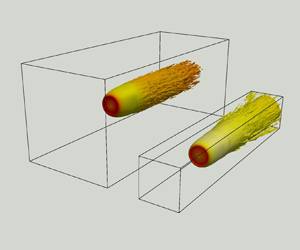Article contents
An analytical blockage correction model for high-solidity turbines
Published online by Cambridge University Press: 20 September 2022
Abstract

A significant challenge in the experimental or computational characterisation of porous bodies and wind turbines is the correction of the obtained flow quantities for wall interference effects. Conventional corrective models are based on the Rankine–Froude theory, which is valid when the body solidity, or turbine induction factor, is sufficiently low. To resolve this issue, this work presents a new corrective model that builds on an extension of the Rankine–Froude theory, valid at arbitrary solidities, coupled with the method of mirror images to account for the existence of channel walls. The predictions of the new model are validated using laboratory and numerical experiments of porous plates and wind turbines. The results show that the new model performs equally as well as conventional ones when the solidity is low, but becomes increasingly more accurate as the latter grows.
JFM classification
- Type
- JFM Papers
- Information
- Copyright
- © The Author(s), 2022. Published by Cambridge University Press
References
REFERENCES
- 5
- Cited by



